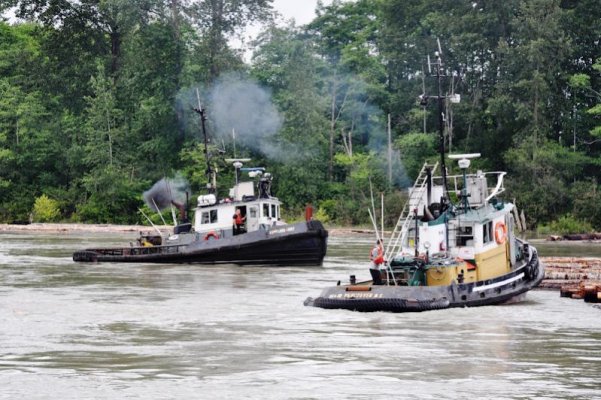yep...ask them....but just not straight transportation of barges...that's easy work...ask them about construction work of precision position holding. They probably would prefer twins...

Well, we've been watching these guys do just that for a couple of decades now, here and up the coast in BC. Positioning docks, assembling and maneuvering huge log rafts, butting big chip barges into position for loading and unloading, maneuvering and holding dredges and spoils barges in position, etc. etc. etc. All with single engine tugs.
Carey and I watched a Fraser River tug precision-align a new 200-foot (approx) floating dock/breakwater in Ganges Marina a number of years ago. Towed the breakwater across the Strait of Georgia from where it had been manufactured up the Fraser and arrived after dark. Dropped the tow and then proceeded to push, nudge, coax and hold the thing into position so the guys on the dock could install the pins connecting it to the floating docks it was being attached to.
It was really impressive watching this single engine (IIRC it had a 16V-71) tug push here, scoot around to the other side and nudge there, then go and hold an end against the current so a pin could be installed, and so on until the dock was aligned and fastened into its final position. It is the single most impressive display of precise maneuvering I've seen to date by far. All with a single engine boat with a pneumatic transmission of some sort--we could hear it-- and no thruster in extremely confined water.
Although I didn't start using it myself at that time, that's perhaps the first time I realized what a wonderful tool power is when maneuvering a boat in close quarters.
We talked to the captain when he was done and fueling for the run back across the strait to the river. We complimented him on his handling of his tug and he thanked us but said that in reality this was one of the easier kinds of jobs they have. Usually they are doing the same sort of thing in terms of precision but contending with the strong current in the Fraser and with much more unwieldy and uncooperatve charges like log boom sections and chip barges. That, he said, is when it can get challenging. The one thing they'd done to this particular tug was install a Kort nozzle a few years before. That, he said, had made maneuvering a little more responsive and precise.
Not saying a twin wouldn't be beneficial in some situations but for what these tugs do day in and day out a single seems to work just fine. If a twin offered advantages over what they use today they'd have long since switched.


 If I had a nice keel/skeg protected prop like you have, it might never have happened. Between the dive to release the anchor line, anchor retrieval and tow off the bank, my tow insurance saved me $1300.
If I had a nice keel/skeg protected prop like you have, it might never have happened. Between the dive to release the anchor line, anchor retrieval and tow off the bank, my tow insurance saved me $1300.


 )
)






